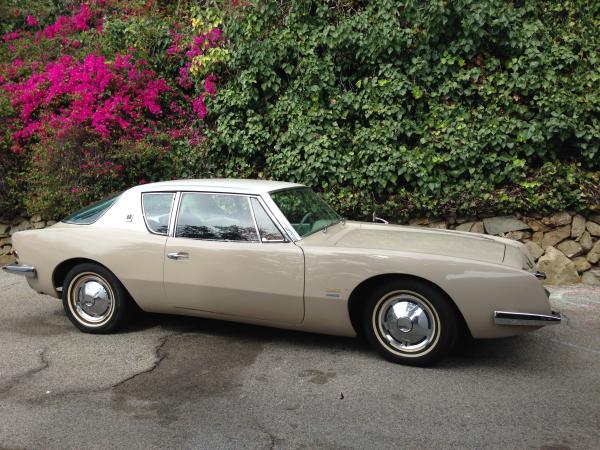This April LACMA’s Decorative Arts and Design Acquisition Committee (DA2) assembled for its third annual meeting. Working with department curators, DA2 acquires 19th-, 20th-, and 21st-century objects for the permanent collection. Through the group’s generosity this year, LACMA now proudly owns 10 exciting new works that build on its department’s strengths and collecting initiatives for California design, the international Arts and Crafts Movement, and graphic design. After persuasive presentations from the curators on each of the objects followed by a lively discussion, DA2 members voted to purchase LACMA’s first car, a 1963 Avanti designed and owned by famed American industrial designer Raymond Loewy. An example of this iconic car, which was designed in Palm Springs, was included in the California Design, 1930–1965: “Living in a Modern Way” exhibition at four of the five museum tour venues. This particular custom model, with its impeccable provenance, is an ideal addition to LACMA’s permanent collection.
![[IMAGE] Margaret De Patta, Pin, c. 1950–64, gift of Suzanne and Ric Kayne throughthe 2014 Decorative Arts and Design Acquisition Committee (DA2)](/sites/default/files/attachments/2-de-patta-pin.jpg) Margaret De Patta, Pin, c. 1950–64, gift of the Kayne Foundation | Suzanne and Ric Kayne through the 2014 Decorative Arts and Design Acquisition Committee (DA2)
Margaret De Patta, Pin, c. 1950–64, gift of the Kayne Foundation | Suzanne and Ric Kayne through the 2014 Decorative Arts and Design Acquisition Committee (DA2)
![[IMAGE] Arline Fisch, Front & Back pectoral, 1971, gift of Allison and Larry Berg through the 2014 Decorative Arts and Design Acquisition Committee (DA2)](/sites/default/files/attachments/3-fisch-front-back.jpg) Arline Fisch, Front & Back pectoral, 1971, gift of Allison and Larry Berg through the 2014 Decorative Arts and Design Acquisition Committee (DA2)
Arline Fisch, Front & Back pectoral, 1971, gift of Allison and Larry Berg through the 2014 Decorative Arts and Design Acquisition Committee (DA2)
With some other DA2 funds, but mostly through the magnanimous enthusiasm of individual members, all the objects up for acquisition at the meeting were purchased for LACMA. A brooch by San Francisco jeweler Margaret De Patta, just returning from tour with the California Design exhibition, is one of them. The piece showcases the artist’s innovative use of nontraditional materials to construct abstract and beautifully balanced works. A second piece of jewelry, Front & Back, is a stunning example of Arline Fisch’s oversized body ornaments. Based in San Diego, Fisch remains a central figure in the Southern California studio jewelry community, and LACMA now has examples from each stage of her long, illustrious career in our collection.
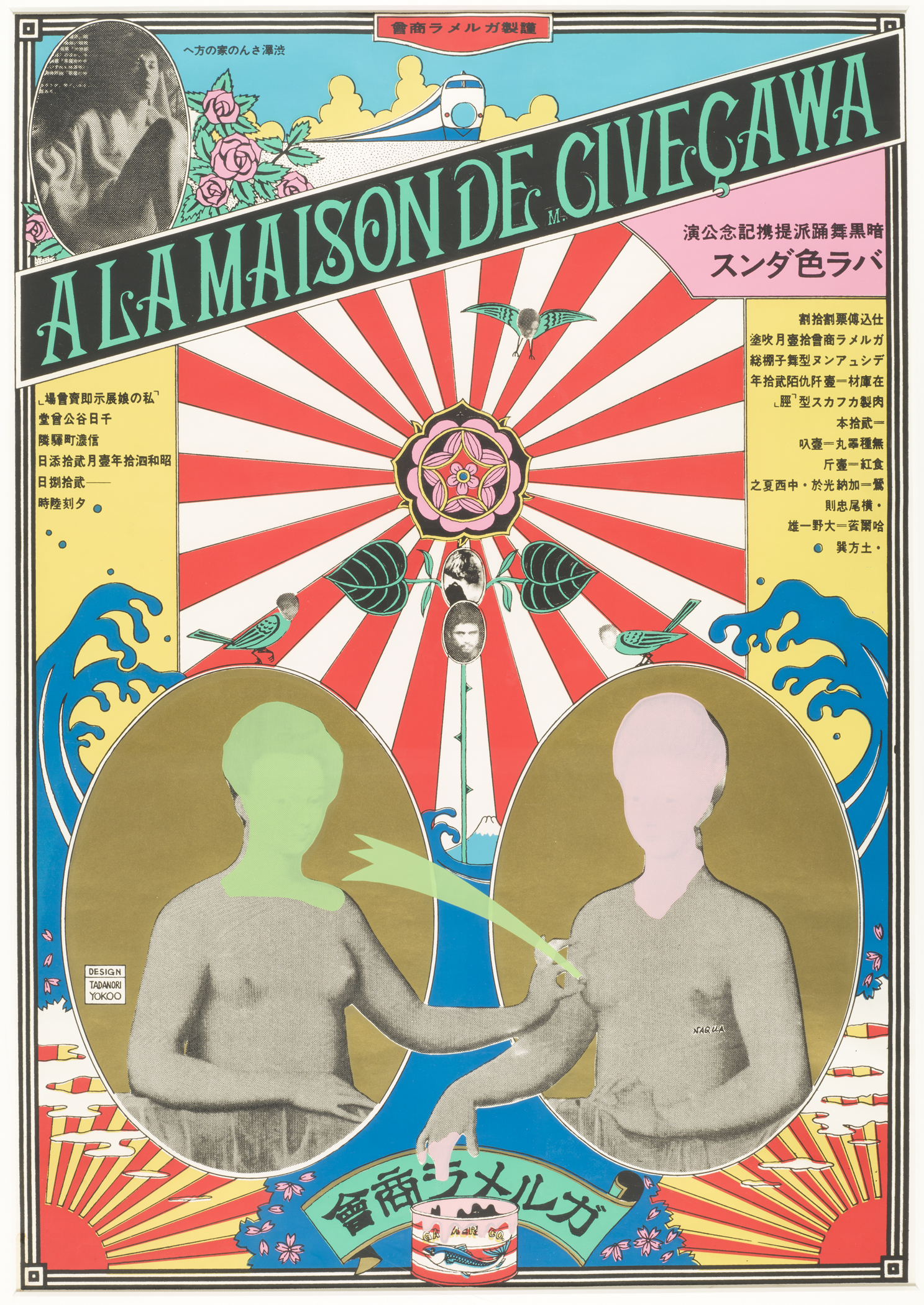 Tadanori Yokoo, A La Maison De M. Civeçawa (At the House of Mr. Shibusawa), 1965, gift of the 2014 Decorative Arts and Design Acquisition Committee (DA²) with Alison and Alexander Palevsky and Maura and Mark Resnick
Tadanori Yokoo, A La Maison De M. Civeçawa (At the House of Mr. Shibusawa), 1965, gift of the 2014 Decorative Arts and Design Acquisition Committee (DA²) with Alison and Alexander Palevsky and Maura and Mark Resnick
With its irreverent symbolism and manic energy, Tadanori Yokoo’s poster A La Maison De M. Civeçawa (At the House of Mr. Shibusawa) exemplifies the early work that garnered immediate acclaim for this important Japanese designer. It complements four later Yokoo posters that were recently donated to LACMA by historian Marc Treib, whose collection is particularly strong in Japanese posters.
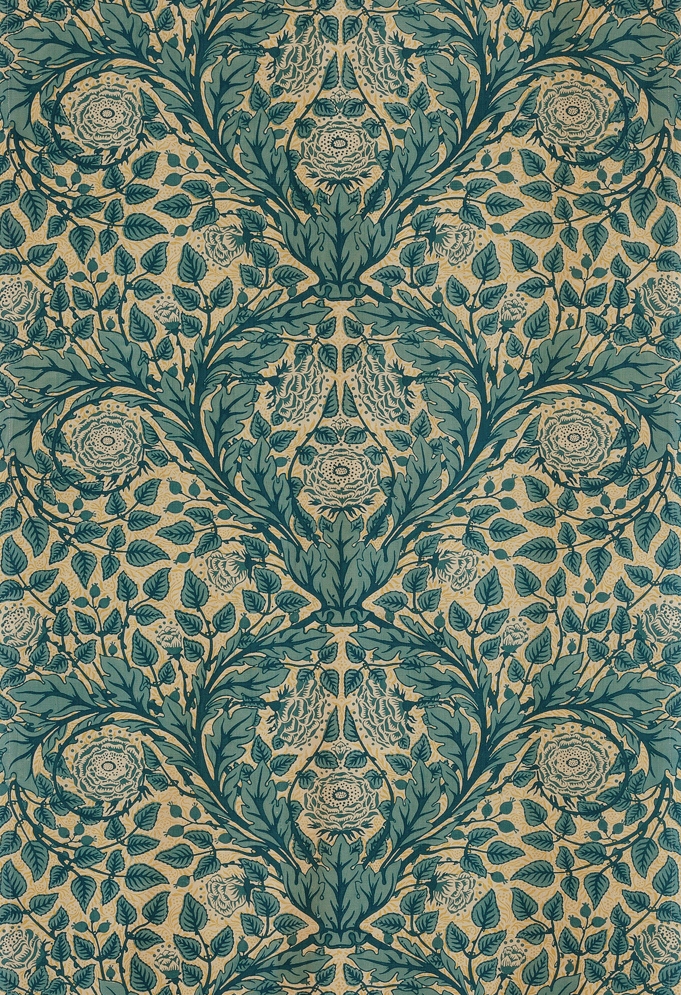 Arthur Heygate Mackmurdo, Textile length, c. 1882, manufactured by Simpson & Godlee, Manchester, for the Century Guild, London, gift of Heidi Wettenhall and Said Saffari through the 2014 Decorative Arts and Design Acquisition Committee (DA2)
Arthur Heygate Mackmurdo, Textile length, c. 1882, manufactured by Simpson & Godlee, Manchester, for the Century Guild, London, gift of Heidi Wettenhall and Said Saffari through the 2014 Decorative Arts and Design Acquisition Committee (DA2)
The six other works acquired all build on LACMA’s already renowned collection of the international Arts and Crafts movement, which was largely assembled through the generosity of the late philanthropist Max Palevsky. These new pieces allow us to show a broader range of work by important designers such as Arthur Heygate Mackmurdo and Bruno Paul, and they also include figures not yet represented in the Decorative Arts and Design collection. When founding the progressive London-based Century Guild in 1882, Mackmurdo sought to restore “joy in labor” through the unification of all art forms. While LACMA co-owns with the Huntington the guild’s most famous design—a chair considered to be the earliest manifestation of the Art Nouveau—this rare and vibrant textile illustrates another important facet of the firm’s production, one celebrated (and illustrated) in Britain’s prominent art journal, the Studio, in 1899.
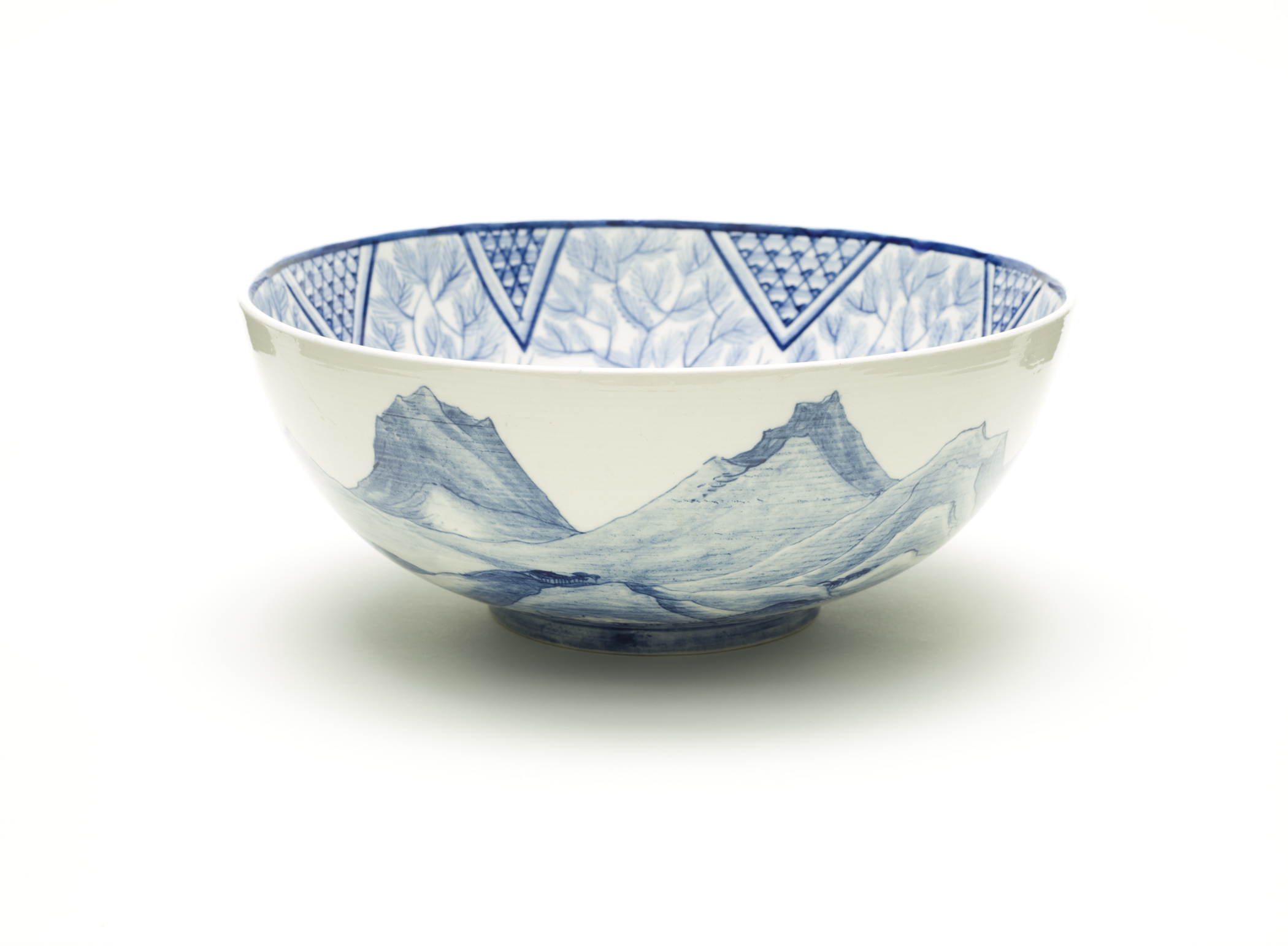 Alfred Powell, Bowl, c. 1910, manufactured by Josiah Wedgwood & Sons, gift of the 2014 Decorative Arts and Design Acquisition Committee (DA²) and the Decorative Arts and Design Council Fund
Alfred Powell, Bowl, c. 1910, manufactured by Josiah Wedgwood & Sons, gift of the 2014 Decorative Arts and Design Acquisition Committee (DA²) and the Decorative Arts and Design Council Fund
Alfred Powell, another key British proponent of Arts and Crafts ideals, is best known for his work as a pottery painter. Collaborating with the English ceramics manufacturer Wedgwood for over 40 years, Powell created designs, trained factory “paintresses,” and produced unique hand-painted wares such as this bowl, with its striking Japanese-inspired landscape and stylized foliage.
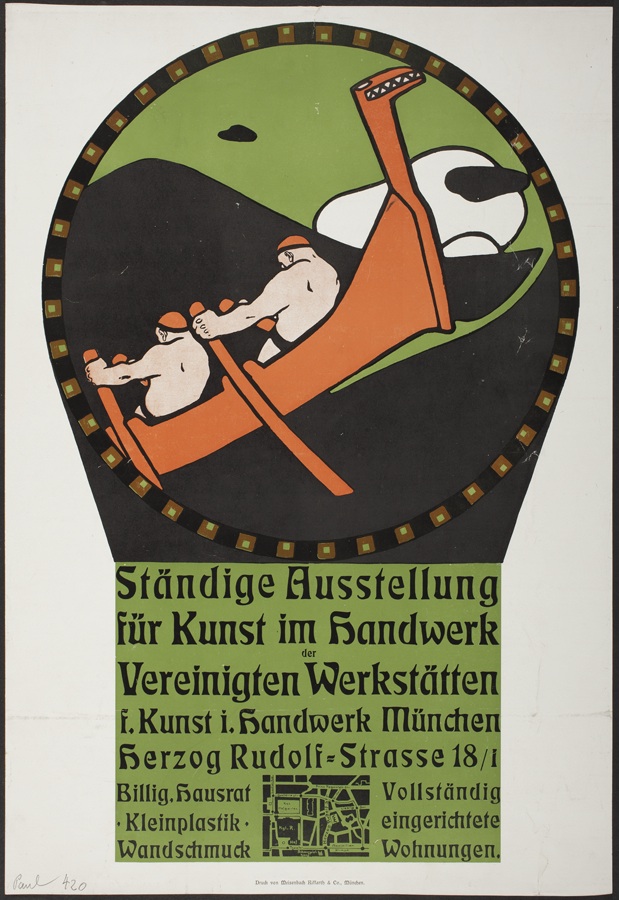 Bruno Paul, Ständige Ausstellung für Kunst im Handwerk (Permanent Exhibition for Art in Handicraft), 1904, gift of Joel and Margaret Chen of J.F. Chen through the 2014 Decorative Arts and Design Acquisition Committee (DA²)
Bruno Paul, Ständige Ausstellung für Kunst im Handwerk (Permanent Exhibition for Art in Handicraft), 1904, gift of Joel and Margaret Chen of J.F. Chen through the 2014 Decorative Arts and Design Acquisition Committee (DA²)
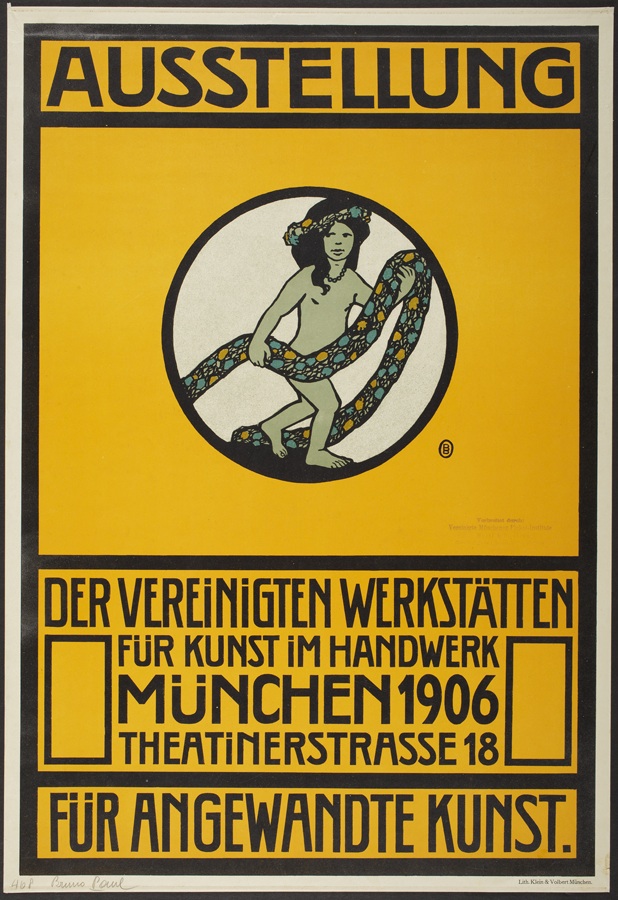 Bruno Paul, Ständige Ausstellung für Kunst im Handwerk (Permanent Exhibition for Art in Handicraft), 1904, gift of Joel and Margaret Chen of J.F. Chen through the 2014 Decorative Arts and Design Acquisition Committee (DA²)
Bruno Paul, Ständige Ausstellung für Kunst im Handwerk (Permanent Exhibition for Art in Handicraft), 1904, gift of Joel and Margaret Chen of J.F. Chen through the 2014 Decorative Arts and Design Acquisition Committee (DA²)
Munich’s Vereinigte Werkstätten für Kunst im Handwerk (United Workshops for Art in Handicraft) played a central role in promoting design reform in Germany’s cultural capital at the turn of the century, and Bruno Paul was one of its most innovative members. These dynamic posters for the organization’s exhibitions were praised in the period for their strong design and, when displayed with the Paul candelabra already in LACMA’s collection, will demonstrate the designer’s work across diverse media.
![[IMAGE] Otto Eckmann, Console, c. 1900, manufactured by Keller & Reiner, Berlin, gift of Shannon and Peter Loughrey, Cheryl Nakao-Miller and Jimmy Miller, and Viveca Paulin-Ferrell and Will Ferrell through the 2014 Decorative Arts and Design Acquisition Committee (DA2)](/sites/default/files/attachments/9-eckmann-console.jpg) Otto Eckmann, Console, c. 1900, manufactured by Keller & Reiner, Berlin, gift of Shannon and Peter Loughrey, Cheryl Nakao-Miller and Jimmy Miller, and Viveca Paulin-Ferrell and Will Ferrell through the 2014 Decorative Arts and Design Acquisition Committee (DA2)
Otto Eckmann, Console, c. 1900, manufactured by Keller & Reiner, Berlin, gift of Shannon and Peter Loughrey, Cheryl Nakao-Miller and Jimmy Miller, and Viveca Paulin-Ferrell and Will Ferrell through the 2014 Decorative Arts and Design Acquisition Committee (DA2)
Also active in Germany, Otto Eckmann—who renounced his career as a painter in 1894 to pursue the decorative arts—designed ceramics, prints, metalwork, furniture, and textiles. While LACMA’s Robert Gore Rifkind Center for German Expressionist Studies has some of Eckmann’s most famous prints, the console (or cabinet) here illustrates the artist’s embrace of the Arts and Crafts ideal of the gesamtkunstwerk (total design unity). It was part of a celebrated music room commissioned by progressive Berlin furniture manufacturer Keller & Reiner, which included en suite furnishings, wallpapers, and textiles.
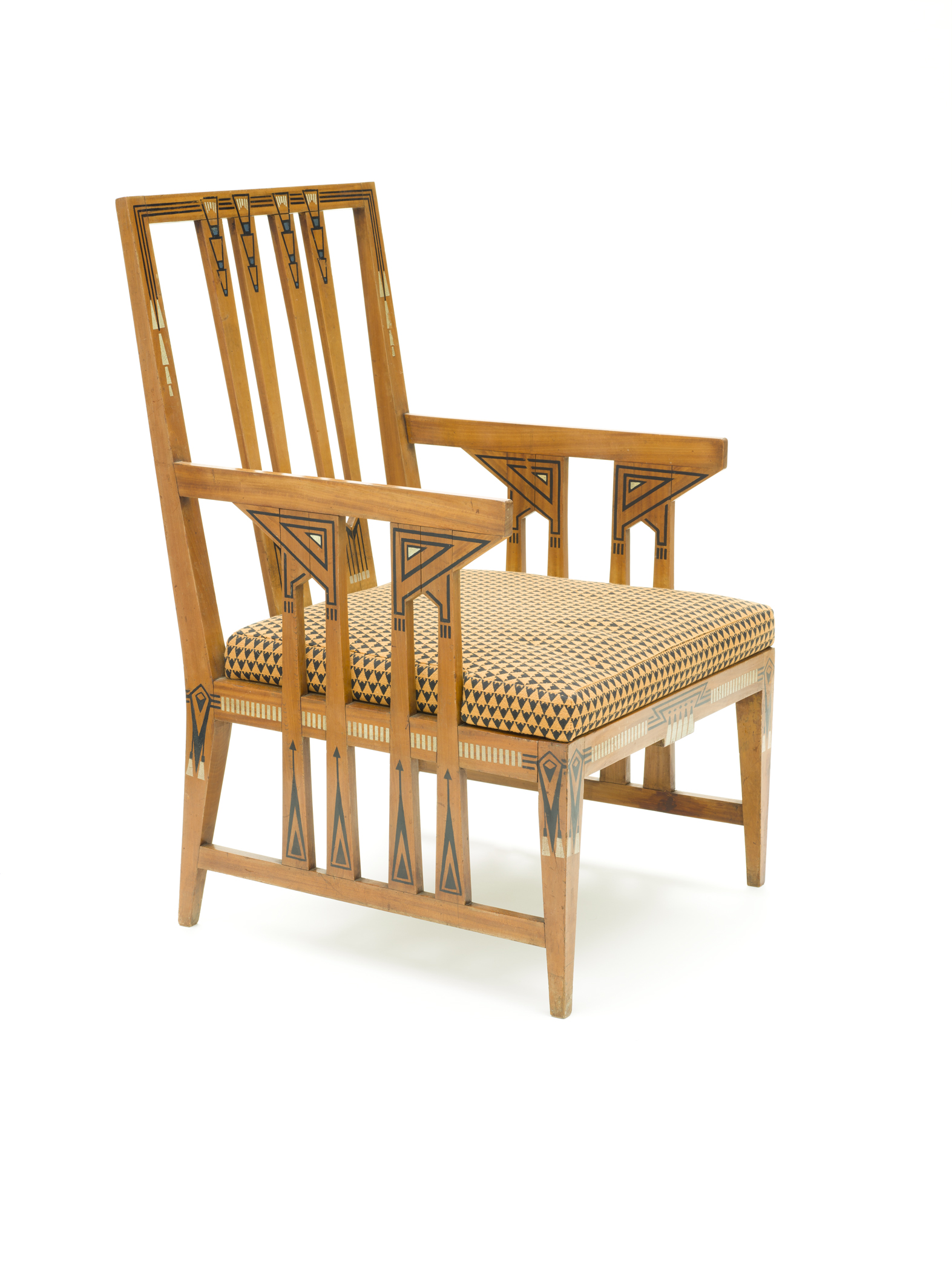 Paul Auscher, Armchair, c. 1911, gift of Debbie and Mark Attanasio through the 2014 Decorative Arts and Design Acquisition Committee (DA2)
Paul Auscher, Armchair, c. 1911, gift of Debbie and Mark Attanasio through the 2014 Decorative Arts and Design Acquisition Committee (DA2)
French architect Paul Auscher also embraced the gesamtkunswerk ideal in designing the building and interiors for his own home in Paris. The armchair we acquired was part of this furniture suite (other pieces are in the Musée d’Orsay collection). The stylized form and decoration relates to the work of other important Arts and Crafts designers in Continental Europe, illustrating the international influences at play in France at the turn of the century, an area underrepresented in LACMA’s collection. From a 19th-century textile to a midcentury car, the objects acquired through the 2014 Decorative Arts and Design Acquisition Committee (DA2) demonstrate the diverse strengths and new collecting initiatives that our department is developing. Support from DA2 and the Decorative Arts and Design Council makes this ambitious program possible, and we look forward to sharing more about these 10 new and important objects through collections online, gallery displays, and future exhibitions. Abbey Chamberlain Brach, Curatorial Assistant, Decorative Arts and Design



